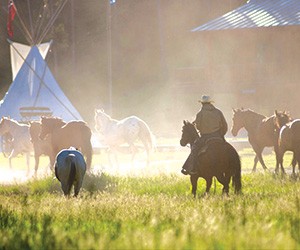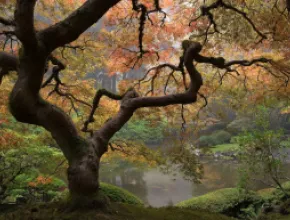Long-celebrated for their laid-back atmosphere and adventurous pursuits, Montana and Wyoming are bursting at the seams with awesome and unexpected experiences and venues for groups. In addition to exhilarating outdoor activities, the two states boast historical sites, thought-provoking cultural experiences and rich regional history that are also wooing attendees to the region.
WYOMING
Last year, the state of Wyoming entered the digital app market full force with the launch of the GoExplore Wyoming smartphone app for both iPhone and Android. Created by Val Burgess of the Burgess Design Group, the app has experienced strong growth and currently has more than 7,000 users. It offers location-based travel itineraries and information on nearby deals, activities and events throughout the state.
“Whether you drive into a city like Sheridan from the north or from the south, if you look up lodging the GoExplore app will tell you the closest hotel and even vibrate to notify you when you are within 50 feet of the property,” Burgess explains.
Burgess has big plans for further development of the app, including billboards at the state’s main entrances prompting visitors to download it and a detailed catalog of the state’s huge array of wildlife, along with species identification tips.
“Wyoming is the Serengeti of the Lower 48,” she says.
Tourism officials are also working with state parks and cultural resources to compile additional information on unusual facts and historic sites.
Jackson Hole
Coming off a big 2011-2012 ski season, Jackson Hole is heating up for a busy summer season as well, and will be leading the way in terms of hospitality and tourism industry sustainability.
The Jackson Hole Chamber of Commerce recently announced that Teton County was one of two U.S. destinations selected to participate in the Global Sustainable Tourism Destination Early Adopters Program. Participating destinations worldwide will have their plans, programs and practices measured against stringent sustainability standards set by the Global Sustainable Tourism Council and promote sustainable destination management.
“Our natural and environmental assets make us attractive as a destination,” says Tim O’Donoghue, executive director of the Jackson Hole Chamber of Commerce. “Our hope is to attract groups that want a destination with proven environmental and social ethics.”
With 8,000 square feet of meeting space, Four Seasons Jackson Hole is stepping up its sustainability by promoting its Eco-Luxe program, which includes planting trees in Grand Teton National Park, shifting to plant-based spa amenities and offering green meetings packages to reduce groups’ carbon footprint.
RockResorts, the owner of Snake River Lodge and Spa, with 5,000 square feet of meeting space, is developing its environmental stewardship program with brand-wide initiatives targeting green golf, water conservation and local forest conservation.
The Best Western Plus Lodge at Jackson Hole completed a renovation this spring, and Hotel Terra Jackson Hole added 60 rooms and 4,200 square feet of meeting space in 2009.PageBreak
Yellowstone
The country’s first national park is a big name in pre- and post-meeting trips, especially if attendees want to experience the day hikes, geyser bursts and selection of museums and visitor centers scattered throughout its 2 million protected acres. One of the most popular ways to experience the park is on tours via vintage yellow buses with rollback tops.
Cody
Founded in 1896, Cody is a true cowboy town, just as expected from a place named after Buffalo Bill.
It is a major gateway to Yellowstone, and this year is the 93rd annual Cody Stampede Rodeo, a Fourth of July weekend celebration with music, entertainment, crafts and barbecue.
Cody welcomes groups and conventions of up to 500 and lodging options range from quaint bed-and-breakfast properties in historical homes to expansive dude ranches. The 70-room, 22-suite Best West Ivy Suites opened near the center of town this year.
Cheyenne
The state capital and seat of Laramie County sits at an elevation of 6,200 feet and is home to Frontier Days, the nation’s largest rodeo, which is in its 116th year.
The Holiday Inn Cheyenne is a staple of local convention business, and the historic Plains Hotel offers 9,000 square feet of meeting space and six meeting rooms.
Meanwhile, the Little America Hotel and Resort features a nine-hole golf course and fine dining at Hathaway’s Restaurant, in addition to 18 breakout rooms and a 13,300-square-foot Grand Ballroom.
Casper
Centrally located Casper weighs in with 2,300 guest rooms and approximately 180,000 square feet of meeting space.
The former frontier outpost promises adventure to visitors. The extreme-sport mecca of Casper Mountain tops out at 8,130 feet, and groups can ride on authentic Oregon Trail covered wagons with Historic Trails West.
The Casper Planetarium and Tate Geological Museum offer a peek into the region’s skies and paleontological history.
Sheridan
According to Penny Becker, executive director of Sheridan Travel and Tourism, Sheridan is enticing to groups because of the Western history they can experience through museums, forts and mansions, as well as big name and local live entertainment.
She says that summer bookings are looking strong, and that Sheridan was named the 2012 “King of Cowboy Towns” by Western Horseman magazine.
A community of 17,000 people and two convention spaces, the Sheridan Holiday Inn–Convention Center and the Best Western Sheridan Center, the city of Sheridan clearly takes pride in its heritage. Forty-six buildings on the National Register of Historic Places are scattered throughout downtown, and venues like the WYO Theater, which was originally built to house vaudeville performances, now showcase local talent.PageBreak
Laramie
Groups in Laramie can stop by the Union Pacific Train Depot, which is available for rental for receptions, parties and other events. The railroad is the main reason for the city’s existence, and the depot was active until 1985. It now functions as a museum and is operated by the Laramie Railroad Depot Association. The three-story Queen Anne Victorian-style Ivinson Mansion is a popular venue for receptions and lawn events.
Campbell County
Thirty-percent of the nation’s coal is produced in Campbell County mines, powering a strong economy and keeping the unemployment rate low.
With the offerings at the massive Cam-Plex center, gatherings in the city of Gillette are bound to be high energy. The 200,000-square-foot Cam-Plex facility sits on more than 1,000 acres and hosts conferences, conventions, performing arts productions, trade shows, rallies, rodeos and national events ranging from high school rodeo championships to pyrotechnic guild meetings.
“Gillette is built for huge groups, especially considering the community only has about 30,000 people,” says Burgess, who also manages public relations for Campbell County. “It is one of the most stable economies nationally, and royalties from the mining industry create discretionary money. When they do things, they do them big.”
Additional Cam-Plex highlights include the 66,000-square-foot Wyoming Center, the 919-seat Heritage Center Theater, stables for more than 1,000 horses and 1,720 campsites.
For off-site activities, there is a historic downtown area in Gillette, coal mine tours and the nearby Durham Ranch, with a population of approximately 3,000 bison.
MONTANA
Billings
The teamwork and entrepreneurial spirit of the Billings Downtown Conference Corridor is emblematic of the city as a whole.
In 2008, a partnership was formed between the Best Western Clocktower Inn and the Crowne Plaza Hotel, which when packaged together form a desirable conference destination offering more than 16,000 square feet of meeting space located within walking distance of several downtown attractions and venues such as the 1,400-seat Alberta Blair Theater, the Yellowstone Art Museum, the Venture Theater and the Montana State University Conference Center.
On the other side of town, the Billings Hotel and Convention Center can accommodate up to 400 attendees and offers more than 750,000 square feet of meeting space with 236 guest rooms and nine suites.
Bozeman
Bozeman is one of the most accessible destinations in Montana, with direct seasonal air service from major hubs and cities such as Seattle, Las Vegas, Salt Lake City, Denver and Minneapolis on airlines including Alaska, Frontier and Delta. The city’s casual streets are lined with art galleries and breweries that offer craft brew tastings.
Big Sky
Groups can get closer than ever to the “big sky,” on the new Lone Peak Expedition at Big Sky Resort, open for the first time this summer. The two-hour tram adventure will transport riders to the 11,116-foot summit of Lone Peak via ski lift, safari vehicle and the new 15-person summit tram offering 360-degree views. Along the way, a guide narrates the journey, explaining local flora, fauna and geography.
The 750-room resort’s renowned skiing, hiking and scenery are complemented by the 46,000-square-foot Yellow Stone Conference Center and 9,000 square feet of meeting and function space at Mountain Village. The community’s easy-to-navigate layout and manageable size are big pluses for groups booking Big Sky.
“It’s a small campus that welcomes big groups,” says Chad Jones, public relations manager for Big Sky.
Team-building activities range from archery and skeet shooting to bungee trampoline jumping.
“We have classic themed group packages like cowboy cookouts, ski ’n’ meets and Powder Power in the winter, but we are very flexible,” Jones says. “We even organized a 5K race for one group.”
Big Sky hosted the 1,000-attendee APEC 2011 Trade Ministerial conference and substantially upgraded audiovisual services to meet the group’s high-level needs.
Twenty-five miles down the road, 21-room Rainbow Ranch Lodge recently partnered with local Amaltheia Organic Dairy to offer a new group culinary package, Get Cultured. This fall, attendees can take goat cheese-making classes and tour the dairy farm, which is home to 430 goats and 200 organic pigs.
Rainbow Ranch specializes in ranch-to-table cuisine. A barn and events tent can host up to 175 guests for receptions and retreats.PageBreak
Glacier Country
Glacier Country Regional Tourism represents eight counties in northwestern Montana, encompassing a region that stretches from Glacier National Park down past Missoula. Last year’s opening of the Bull Barn Conference Center and Event Hall at The Resort at Paw’s Up was big news for event organizers, and Racene Friede, executive director of Glacier Country Regional Tourism, describes the space as “very inviting to meeting planners” and “great for corporate retreats.”
According to Friede, much of western Montana’s allure comes from the recreational opportunities, open space and natural resources. One of her favorite views is the stunning Flathead Lake, located south of Kalispell. The lake is 27 miles long, 15 miles wide and has more than 180 miles of shoreline. Groups can stay nearby at The Lodge at Whitefish Lake in the Flathead Valley, with more than 10,000 square feet of meeting space, a spa and a marina.
Another spot to check out is Brennan’s Wave on the Clark Fork River in Missoula. Close to downtown hotels and conference centers, attendees can watch kayakers practice flips and tricks on the man-made wave, created in memory of talented local paddler Brennan Guth, who died in 2001 while kayaking in South America.
Also situated along the river is the DoubleTree by Hilton Hotel Missoula–Edgewater conference hotel, with 9,000 square feet of meeting space and an outdoor deck at the property’s Finn and Porter restaurant.
Helena
Located between Yellowstone and Glacier National Parks, Helena is a natural choice for outdoorsy groups looking to explore the surrounding wilderness, but Montana’s capital city is also a burgeoning art hub. Meetings in the city and side trips to the national parks are easy to arrange, or groups can stick around town and explore the urban setting.
According to Heidi O’Brien, director of sales and marketing for Helena Tourism, the city is currently developing the historical and cultural aspects of its group tourism offerings.
“We are realizing that many products we already have will work on a group level,” she says.
Examples of this versatility include the contemporary Holter Museum of Art, which is celebrating its 25th anniversary this year and offers hands-on interactive tours; the Archie Bray Foundation for Ceramic Arts, which offers guided tours of the 26-acre former brickyard; and photography workshops with Jason Savage, a famous Montanan and outdoor photographer. Walking tours of the city’s large historic district as well as the West Side Mansion District are also available.
Helena launched a new tourism website in May (www.helenamt.com) and is trying to expand the variety of groups the destination draws.
“As the capital, we attract a lot of statewide meetings, especially during legislative years,” O’Brien says. “We’re working hard to please smaller groups that are looking for something different.”
One of the biggest group spaces in town is the Best Western Premier Great Northern, with 8,000 square feet of meeting and banquet space that accommodates groups of up to 500.
Great Falls
Great Falls is growing as a meetings destination and now has more than 2,000 available rooms and 150,000 square feet of meeting space.
Local cultural offerings include the Great Falls Symphony Association and the 1,782-seat Mansfield Center for the Performing Arts, located near the Mansfield Convention Center and built by the Works Progress Administration during the New Deal era.
However, Great Falls hasn’t forgotten its roots, as evidenced by the newest permanent exhibition at the CM Russel Museum, Bison: American Icon, Heart of Plains Indian Culture. Named after artist and “consummate Westerner” Charles Marion Russell, the museum offers special group tours.
Five minutes from Great Falls International Airport, Hampton Inn Great falls has 97 guest rooms and a 3,000-square-foot meeting room.
With a diverse array of attractions and new technology to enhance a group’s experience, it is no wonder that the Western charm and stunning scenery of Wyoming and Montana always draw groups back.
“There is no way you can experience it all in one trip,” Friede says.






